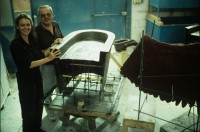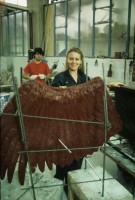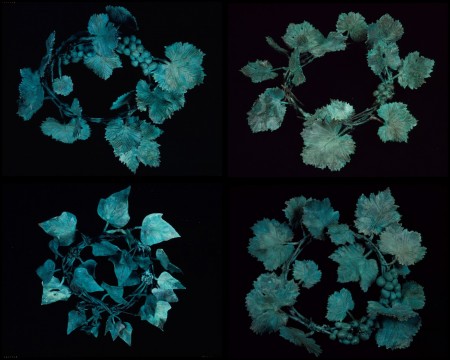The Tubs of Aphrodite
Dream
I am in an unknown sanctuary on a hillside. The hill is terraced with parts of the sanctuary occupying three different levels. The uppermost room of the sanctuary is roofed, the lower open to the sky. The atmosphere is hushed, the silence which precedes either the mysteries or a natural disaster.
I am with Yvonne on the terrace. In front of me I see a large Roman tub made of copper. The tub begins to rock with the tremors and overturns. I mount it like a capsized boat and am saved, but Yvonne is crushed underneath and dies. The quake has sent mudslides into the sanctuary, torrents of mud and water.

One month before going to Rome in 1989 I had the preceding dream. My first morning there I took a walk on the Via Dandolo, near the American Academy in Rome. Discovering at the bottom of the Villa Sciarra, the Syrian Sanctuary, preserved like a bee in amber. Its general plan was exactly like the sanctuary in my dream.
The Syrian Sanctuary contained an open-air temenos –a consecrated area- on the lower two levels and a vaulted sanctuary on the upper levels. Later I learned that mud slides had covered the back walls of the temple in antiquity, preserving them up to their vaults.
 The Syrian Sanctuary, in dreams and in reality, became a stage set for a divine drama. As a modern woman and an artist, the sanctuary, its purposes and uses, the Goddesses Aphrodite and Dea Syria, and the principles they stand for, have come to life in a special way.
The Syrian Sanctuary, in dreams and in reality, became a stage set for a divine drama. As a modern woman and an artist, the sanctuary, its purposes and uses, the Goddesses Aphrodite and Dea Syria, and the principles they stand for, have come to life in a special way.
In the dream I was saved, by crawling inside the copper tub. Copper belongs to Aphrodite, it is her metal, and acts as a conductor for her energies. The tub, sea, and the bath are her domain. The Eros principle of Aphrodite, is also the agent of dissolution: in the dream I am saved by bathing in the Eros principle.
The sanctuary and the tub are filled with mud and water. In many creation myths, water is the original matter out of which the world is created. Because it fills the womb the womb, water is related to birth. The earth element is also key, as in many Native American creation myths. A ball of mud is brought up through the waters, or a ball of earth is scraped from the arm of the Creator to from the world. Here the earth and water cause one form to disappear, and a new, regenerated one to emerge.

The spring, the pool and the use of water in the pagan mystery religions, and those that followed, are linked to the power of the moisture principle, a primary source of life. Bothe Aphrodite and Dionysus are associated with water; they are associated with spontaneity, regeneration, and feel as opposed to restraint more associated with Apollo. Aphrodite symbolizes birth, fertility, and procreation. The bath and immersion images relate to baptism, healing, and rejuvenation.
 Socrates and Plato imply that it is women-Aphrodite, Diotima, and Sappho- to whom one goes for the truthful vision of love. The academies of Aphrodite taught not only love, also positive human relations, and ethics in the ancient world, even soldiers studied at her academies. We need this positive Eros more today than ever.
Socrates and Plato imply that it is women-Aphrodite, Diotima, and Sappho- to whom one goes for the truthful vision of love. The academies of Aphrodite taught not only love, also positive human relations, and ethics in the ancient world, even soldiers studied at her academies. We need this positive Eros more today than ever.
Aphrodite was not without her dark side, in the form of nymphs who lure men to their deaths in deep waters. The goddess can also be implacable and remorseless, the root cause of hatred, rivalry, jealousy, and cruelty, as we learn from the hymns of Sappho.
Vasca I
Vasca I
Cast bronze from lost wax
24” by 56” by 50”
Inscription
“Your golden chariot yoked: sparrows beautiful and swift conveyed you, with rapid wings a flutter, above the dark earth from heaven through mid-air;
And soon they were come, and you, fortunate with a smile on your immortal face, asked what ails me now, and why I am calling now”
Sappho
Vasca II
Vasca II
Cast bronze from lost wax
38 ½” by 97” by 116”
Inscription
“Richly-enthroned immortal Aphrodite, daughter of Zeus, weaver of wiles, I pray to you: break not my spirit. Lady, with heartache or anguish”
Sappho
I made the winged tubs because for me they seemed to come from the heavens. Aphrodite is ornithic, and is often paired with the dove, the goose, and the swan. Or she is born by waterfowl.
Ann McCoy
Rome 1990



